
Do Hospital Beds Have Wheels?
2024-11-26 15:30
In our impression, everything in a hospital seems extremely professional and rigorous, and one of the most conspicuous equipment is the hospital bed. These beds usually come with various complex functions and seem to be able to adjust to the comfort needs of every patient. However, have you noticed that almost all hospital beds have wheels? What is the use of these wheels? Beds with wheels are not only standard in hospitals, but also an indispensable and important part of the entire medical care process.
Let's take a deeper look at why hospital beds have wheels and what important role these wheels play in medical care.
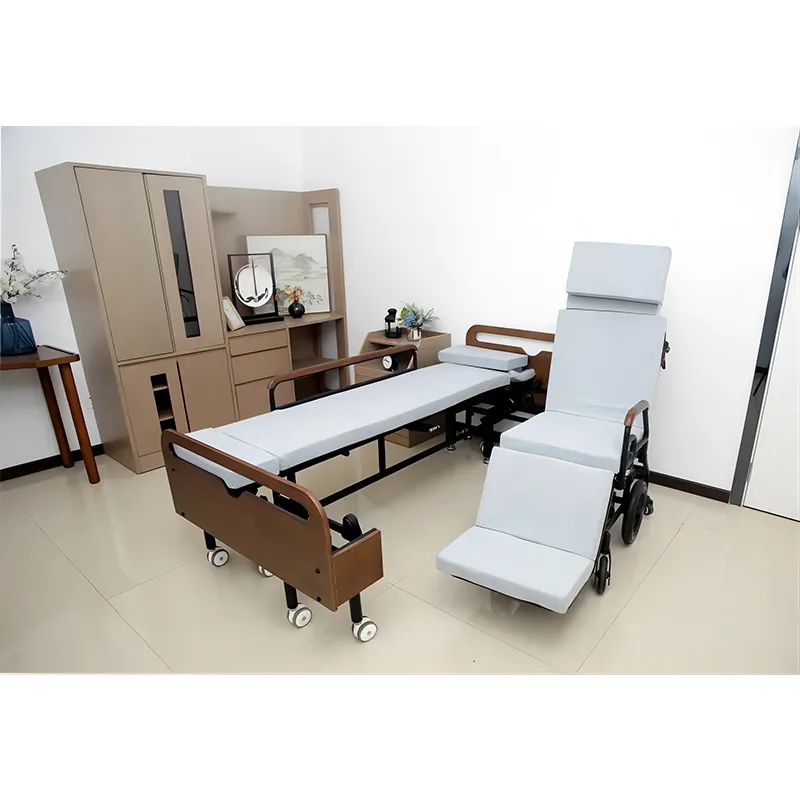
Do Hospital Beds Have Wheels?
The answer is very simple: yes, hospital beds do have wheels. In fact, wheels are standard for almost all modern hospital beds. Whether it is a simple bed we see in the emergency room or a high-level care bed in the ICU, wheels are almost installed. These wheels are not just for moving the bed. There are complex design considerations and clinical needs behind them.
Wheels are an important part of hospital beds:
Hospital beds are equipped with wheels to meet the diverse needs in the medical environment. The wheels are designed not only to enable the bed to move on the ground, but also to take into account multiple aspects, such as patient safety, convenience of medical operations, and space utilization in wards. Therefore, the wheels of the hospital bed are not a simple "accessory", but an indispensable part of the design of the bed.
From first aid to daily care, wheels are everywhere:
Whether in the emergency scene where patients need to be moved quickly in the emergency room, or in daily care in the general ward, the wheels of the hospital bed play a vital role. They enable caregivers to easily move patients from one place to another without using additional equipment or consuming a lot of manpower. This not only improves the efficiency of care, but also greatly reduces the risks that may arise in the process of moving patients.
Therefore, we can conclude that hospital beds not only have wheels, but these wheels play an important role in medical care and provide great convenience for the daily operation of the hospital.
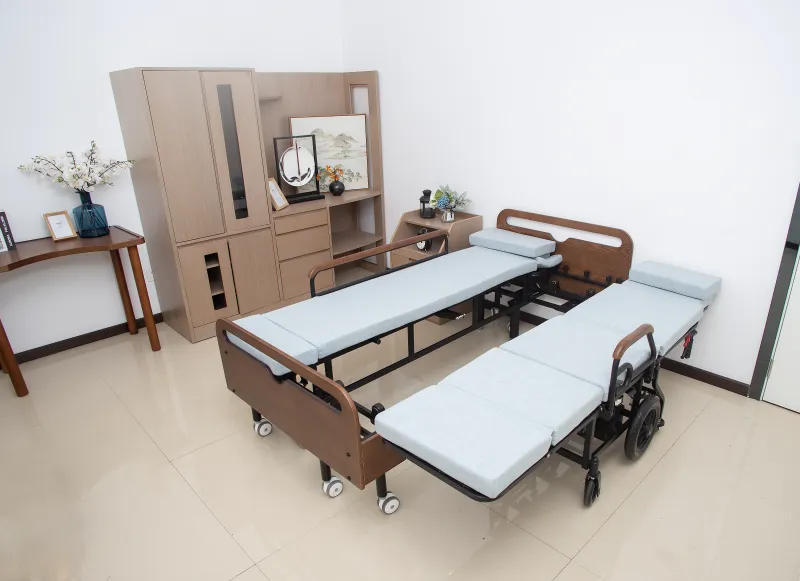
Why Do Hospital Beds Need Wheels?
Now that we have made it clear that hospital beds do have wheels, the next thing we want to explore is, why do these beds need wheels? There are several key reasons, including the convenience of movement, the needs of medical operations, and the diversity of patient care.
Convenience of mobility:
The hospital is a dynamic environment, and the patient's condition may change at any time, and may need to be urgently transferred to other departments for further examination or treatment. In this case, a bed with wheels allows caregivers to quickly move patients from one place to another without having to let the patient leave the bed. This not only saves time, but also reduces the additional discomfort or risk that the patient may suffer during the move.
Demand for medical operations:
In the hospital, medical operations often need to be performed on the bed, such as dressing changes, examinations, intubation, etc. Some operations may need to be completed in the operating room or other specialized medical areas, in which case the bed needs to be moved together with the patient. Wheels make these operations simpler and more efficient, and caregivers can get patients to where they need to be in the shortest time without interrupting the continuity of medical procedures.
Diversity of patient care:
The care needs of patients in the hospital vary greatly. Some patients may need frequent changes in position or transfers, while others may need to move between special equipment. For example, transferring from an ordinary bed to an operating table or rehabilitation training equipment. Wheels make these transfers easier, reducing the physical exertion of caregivers and the risks to patients during the transfer process.
Handling emergency situations:
In emergency situations, such as sudden cardiac arrest or other life-threatening emergencies, the rapid transfer of patients can be a matter of life and death. The presence of wheels allows patients to be sent to the emergency room or operating room in the shortest possible time, buying precious time for rescue.
In summary, hospital beds need wheels not only for easy mobility, but also to cope with various complex needs in the medical environment and ensure that patients can be provided with the best care in any situation.
In addition to the Hospital, how Can Wheels Help You Aat Home?
When caring at home, caregivers may need to frequently adjust the position of the bed. For example, push the bed into the sun so that the patient can bask in the sun, or push it into the living room so that the patient can participate in family activities. These operations require the bed to have flexible mobility, and wheels can provide this function.
Space in the home is often limited, especially in small-sized homes. The wheels of the bed allow the bed to be flexibly adjusted when needed, and can be placed aside when not in use, thereby maximizing the use of home space. This is especially important for patients who need to undergo rehabilitation training or use medical equipment at home. Even at home, emergencies may occur, such as when a patient's condition suddenly worsens and needs to be rushed to the hospital. At this time, a bed with wheels can quickly push the patient to the door, making it easier for emergency personnel to handle it, thereby gaining precious rescue time.
In addition, the presence of wheels also reduces the burden on caregivers when nursing at home. For example, when it is necessary to change the sheets for the patient or perform other nursing operations, the bed with wheels can be easily moved to a position that is easy for the caregiver to operate. This not only improves the efficiency of nursing, but also reduces the fatigue of the caregiver.
For patients who have been bedridden for a long time, being able to experience different environments in different locations at home has a positive impact on psychological comfort. Wheels make it easier to move the bed, and patients can choose different positions according to their needs, such as near the window to enjoy the sun, or near the TV to watch programs, thereby improving the quality of life.
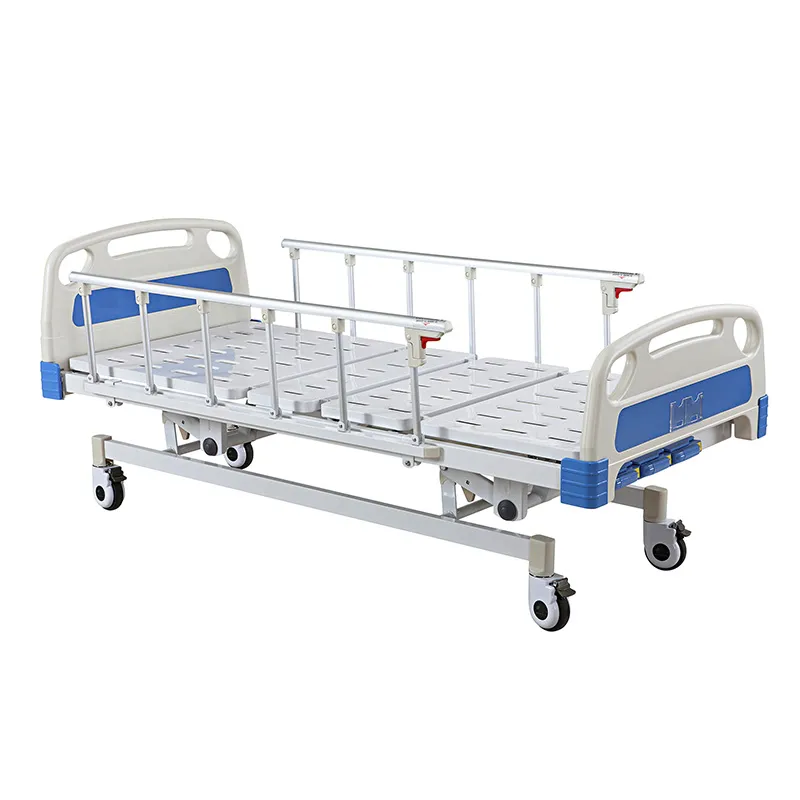
Why Must the Wheels of the Bed Have a High-Quality Locking Mechanism?
In the hospital, the bed may be placed on a sloping ground or on a smooth floor. Without a high-quality locking mechanism, the bed may move without the patient noticing, causing the patient to slip or fall. The locking mechanism can effectively prevent this accidental sliding, ensuring that the bed remains stable during use and avoiding unnecessary accidents.
The stability of the bed is crucial when performing some complex medical operations, such as intubation, dressing changes or surgery. If the bed moves during the operation, it may affect the accuracy of the operation and even cause harm to the patient. A high-quality locking mechanism can ensure that the bed remains completely still during the operation, providing a safe and stable operating platform.
For patients, psychological security is equally important. If patients feel that the bed is constantly moving or shaking, it may cause anxiety or uneasiness, affecting their recovery process. The presence of a locking mechanism can provide patients with a sense of stability and increase their trust in the treatment environment, thereby contributing to psychological recovery.
In addition, in a busy hospital environment, nursing staff may accidentally touch the bed during nursing operations, causing the bed to move. If the bed is not locked, it may cause unnecessary trouble or safety hazards. A high-quality locking mechanism can prevent this from happening and reduce the risks caused by misoperation. Some multifunctional beds are also designed with complex adjustment systems that can adjust the height, inclination, etc. of the bed. These adjustments need to be made when the bed is completely stable to ensure the accuracy and safety of the adjustment. High-quality locking mechanisms are particularly important in such cases.
In summary, the high-quality locking mechanism of the bed wheels is the last line of defense for patient safety. It not only prevents the bed from sliding accidentally, but also provides the necessary stability for medical operations, thereby protecting the safety of patients and caregivers.
How Many Wheels Does a Bed Have?
Standard hospital beds are usually equipped with four wheels. These wheels are distributed at the four corners of the bed to provide maximum stability and mobility. This design takes into account not only the balance of the bed, but also the load-bearing capacity of the wheels, so that the bed can perform at its best in various medical scenarios.
Why Does the Bed Have Four Wheels?
The design of four wheels can provide the bed with the best balance and support. Each wheel carries part of the weight of the bed, ensuring that the bed can travel smoothly when moving without tilting or instability. The configuration of four wheels also enables the bed to turn flexibly in a narrow space, making it easier for nursing staff to operate in the ward.
Different types of wheel designs:
Although four wheels are standard for hospital beds, different types of beds may use different wheel designs. For example, some advanced beds may be equipped with larger and stronger wheels to carry more weight or provide smoother movement. Some beds are also equipped with swivel wheels or universal wheels, which enable more flexible movement and positioning.
Load-bearing capacity of wheels:
The load-bearing capacity of the wheels of the bed is a very important factor in the design. Each wheel must be able to withstand a certain weight to ensure that the bed can still move normally when carrying patients and other medical equipment. Usually, the load-bearing capacity of each wheel will be marked in the technical specifications of the bed, and nursing staff can choose the appropriate wheel configuration as needed.
Material and structure of wheels:
The material and structure of the wheels of the bed are also key factors in determining its performance. Generally speaking, the wheels are usually made of wear-resistant and pressure-resistant materials, such as rubber or high-strength plastic. These materials can not only bear the weight of the bed, but also run smoothly under various ground conditions. The structural design of the wheels also takes into account the reduction of friction and noise to improve the overall use experience of the bed.
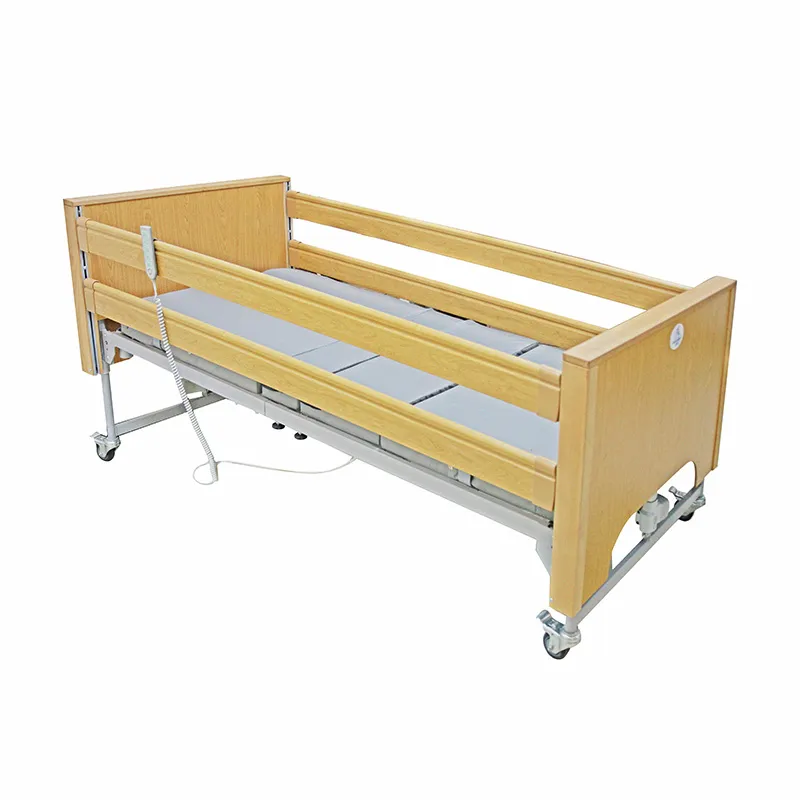
How Do You Push a Hospital Bed?
When pushing a bed, the caregiver should maintain the correct posture, usually standing at one end of the bed, holding the push rod or bedside head with both hands, and then push the bed to the target position with moderate force. During the pushing process, the caregiver should keep his back straight and avoid bending over or overexerting to reduce the pressure and fatigue on himself.
When moving the bed, the caregiver also needs to pay attention to the condition of the ground. If the ground is smooth, the bed may move too fast, increasing the patient's discomfort; if the ground is uneven, it may cause the bed to shake or get stuck. Therefore, when pushing the bed, the caregiver should maintain a moderate speed and adjust the thrust at any time to cope with different ground conditions.
The wheel design of most hospital beds allows forward and backward movement, but in narrow spaces or when turning is required, caregivers need to pay special attention to the direction control of the wheels. Beds with universal wheels can easily achieve turning and direction adjustment, but during the push process, you still need to be careful to avoid sudden turns to prevent the bed from tilting or colliding.
Before moving the bed, the caregiver should ensure that the patient is in a safe state. For example, check the patient's body position to ensure that they are in a comfortable and stable position on the bed. It is also necessary to check all the locking mechanisms of the bed to ensure that the parts of the bed will not move unexpectedly or loosen during the move.
In some cases, such as when the bed needs to pass through a narrow door or enter an elevator, the coordination of multiple caregivers may be required. One caregiver is responsible for pushing the bed, while another is responsible for guiding and ensuring that the bed passes smoothly through the narrow area. In these cases, cooperation and communication between caregivers are essential to ensure that the bed can be moved safely and smoothly to the target location.
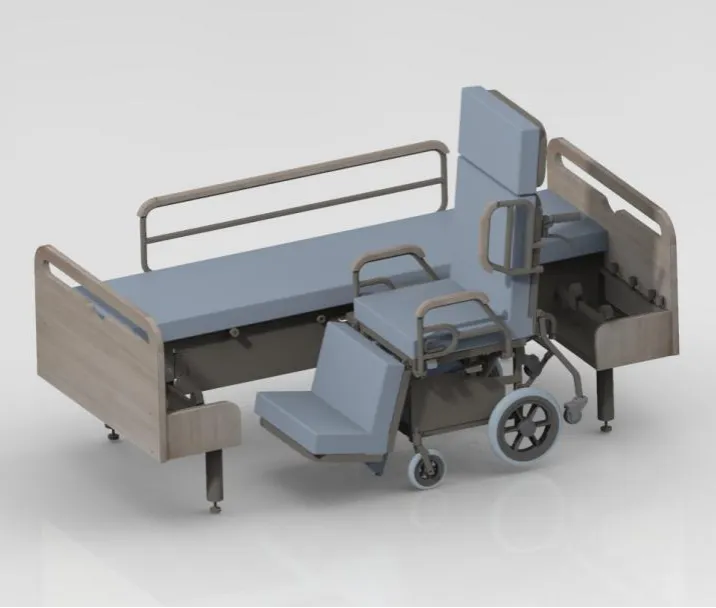
How Much Does a Hospital Bed Weigh?
The weight of a hospital bed varies depending on the model and function. Generally speaking, the weight of a standard hospital bed is about 150 to 300 pounds (about 68 to 136 kilograms). The weight depends on the material, structure, function and design requirements of the bed.
Factors affecting the weight of hospital beds:
● Material: The material of a hospital bed is an important factor in determining its weight. Steel bed frames are usually heavier, while aluminum or plastic beds are relatively lighter. However, heavier steel bed frames usually have better stability and durability, suitable for long-term use and carrying larger weights.
● Function and design: Multifunctional beds are usually heavier than standard beds because they are equipped with more adjustment and support equipment, such as electric lifting systems, angle adjustment mechanisms, and additional safety devices. Although these additional functions increase the weight of the bed, they also improve its operational convenience and patient comfort.
● Type of bed: Different types of beds also have different weights. For example, intensive care beds are usually heavier because they need to provide more stable support and more complex adjustment functions. In contrast, portable or temporary beds are designed to be lighter for quick deployment and handling.
Impact of weight on operation:
The weight of a bed directly affects the difficulty of moving and operating it. Heavier beds may require more caregivers to push, pull, and adjust, while lighter beds are easier to operate. However, weight is not the only consideration when choosing a hospital bed. The stability, durability and functionality of the bed are equally important.
The relationship between weight and stability:
Although heavier beds may not be as flexible as lightweight beds when moving, they usually have better stability, especially when performing some complex medical operations, the stability of the bed is crucial. Therefore, hospitals usually choose beds of appropriate weight to balance operational convenience and stability based on the specific needs and care requirements of patients.








